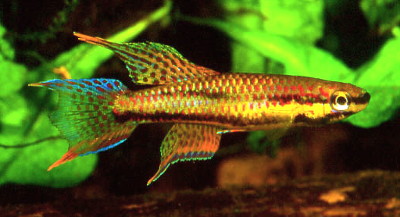Aphyosemion ecucuense Sonnenberg 2007

A.ecucuense GEMLBJ 03 / 47. Photo courtesy of Werner Eigelshofen.
| Meaning of Name |
After the Rio Ecucu. |
|
| First Description |
Sonnenberg R. 2007. Two new species of Chromaphyosemion (Cyprinodontiformes:
Nothobranchiidae) from the coastal plain of Equatorial Guinea. Ichthyol. Explor.Freshwaters, Vol. 18, No. 4, pp. 359-373, 7 figs, 4 tabs, December 2007. |
|
| Size |
Holotype - Male, 27·8 mm SL. |
|
| Meristics | ||
| Karyotype |
|
|
| Sub-Genus |
Chromaphyosemion |
|
| Group |
|
|
| Synonyms |
|
|
|
Populations
|
GEMHS 00 / 25 - Ncomedyi.
A brown form. GEMHS 00 / 26 - Bata. A
brown form. Collected 25 kms in the direction of Niefang. GEMLBJ 03 / 36 - Nfua River on the road between Buta & Niefang near mile post km 36. Elevation 193 metres. Type locality. GEMLBJ 03 / 42 - Same location as GEML 00 / 15 & GEMLB 02 / 32. Rio Ecucu Basin. Found in a river near Bicomo near the power station. Elevation 50 metres.
GEMLBJ 03 / 47 - A brown form. Rio Ecucu Basin. Found in a creek crossing the road from east of Bata - Niefang near Machinda. Elevation 180 metres. |
|
| Type Locality |
GEMLBJ 03 / 36. Located 36 kms east of Bata at km stone 36. Elevation 193 metres. |
|
| Distribution |
Northwestern Equatorial Guinea within the middle & upper Rio Ecucu drainage. |
|
| Habitat | ||
| Distinguishing Characteristics | This
species is part of a small group comprising A.kouamense,
A.malumbresi, A.melanogaster
& A.erythron that have red dots
in all unpaired fins. These rarely join. A.ecucuense can be seperated from others in this group by an orange to copper body colour which is blue to bluish in A.malumbresi, greenish in A.melanogaster, light blue background with rows of red dots in A.erythron & blue with anteriorly reddish to orange in A.kouamense. In A.ecucuense the anal fin is orange whereas A.puctulatum & A.erythron has an anal fin colouration predominantly green. |
|
| Colour/Pattern Variability | ||
| History |
Holotypes were collected 36 km east of Bata,
Rio Ecucu Basin by J.J.Scheel February 1968. |
|
| Breeding Notes |
Bill Drake wrote report in BKA newsletter No.530,
November 2009. This concerned population GEMC 06 / 7. A pair was set
up in ater of pH 6·5, Hardness 2°, filtered for 24-48 hours.
Java moss & mops were added. After 14 days about 20 eggs were collected
but only 50% hatched out. No more eggs were found after this & the
male later died. From the 10 hatched eggs only 8 survived to adulthood
which turned out to be 3 males & 5 females. Young + the original
old female were spawned. A pair would give about 20 eggs in a week. |
|
| Diameter of Egg | ||
| Remarks |
Referenced material for this page from first description kindly supplied by Rainer Sonnenberg. |
